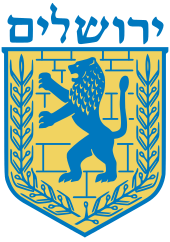King's Garden (Jerusalem)
The King's Garden (Hebrew: גן המלך, Gan HaMelekh), known in Arabic: البستان as Al-Bustan, is a well-watered area south of the Temple Mount and the Wadi Hilweh/City of David neighbourhood in East Jerusalem. It is known under the name 'King's Garden' from the Hebrew Bible. Al-Bustan is one neighbourhood of the extended Arab village of Silwan, and consists of something over 100 houses.[1]
A controversial proposed development project envisions demolishing the existing houses, which were erected without building permits, creating a park, while constructing new four-story apartment buildings around it, to which the current residents would be relocated.[1]
The land is traditionally considered as once part of the royal gardens of the Israelite kings.[2] The area has been occupied by Jordan from 1948 until 1967 when it was occupied by Israel, who then, in a move condemned internationally, annexed it in 1980.
Location
The only place in historical Jerusalem where water is flowing year-round, thanks to the nearby Gihon Spring, allowing for permanent growth of natural vegetation and agriculture, is at the confluence of the Kidron and the Central (aka Tyropoeon) valleys.[3]
The "King's Garden" in the Hebrew Bible
The place is known from the Hebrew Bible as 'Gan HaMelekh', the King's Garden.[3] The term is used repeatedly (2 Kings 25:4; Jeremiah 39:4; Nehemiah 3:15) and the area seems to also be referred to in Zechariah 14:10, which mentions "the royal winepresses".[3]
Plan
The proposed development would include a watercourse flowing south from the Gihon Spring through a landscaped park, housing, and restaurants and shops for tourists.[4]
Controversy
According to the municipal government, the area proposed for development is classified as an "open recreational space," but is actually the site of "dozens of structures (that) have been erected without permits."[4][1] Old photographs of the Garden of the King show the proposed park as terraced farmland below the village of Silwan.[5]
According to the Jerusalem municipality, there were no more than four buildings in 1967, but now it is a ghetto with 120 families living in sub-standard housing erected without permits on public parkland.[4] The city plan will accommodate all of the families in new housing to be constructed along the edges of the park.[4][1]
Residents of the houses slated for demolition acknowledge that their neighborhood is in a state of disrepair, but demand that the housing be improved, not demolished.[1] They have demanded legal permits for their existing, unauthorized homes and vowed that "We'll never leave our homes".[6] According to the Israeli newspaper Haaretz, "No one in the neighborhood denies that the homes were built illegally", but residents assert that they were forced to build illegally on the open land because the city refused to give building permits.[7]
References
- 1 2 3 4 5 Abe Selig, Gan Hamelech residents wary of Barkat's redevelopment plan, Feb. 16, 2010, Jerusalem Post. Accessed August 1, 2016
- ↑ Cyclopaedia of Biblical, Theological and Ecclesiastical Literature, John McClintock, Harper and Brothers, 1889, p. 745.
- 1 2 3 E. W. G. (Ernest William Gurney) Masterman, King's Garden, in the International Standard Bible Encyclopedia via BibleHub.com
- 1 2 3 4 The King's Garden (Gan Hamelech, Al Bustan) - Development Plan, 02/03/2010, Jerusalem City Hall website.
- ↑ "King's Garden and village," photographed by James Graham can be found on pp. 31, 35 of Picturing Jerusalem; James Graham and Mendel Diness, Photographers, Israel Museum, Jerusalem, 2007.
- ↑ "Gan Hamelech residents vow never to leave their homes", Abe Selig, March 4, 2010, The Jerusalem Post.
- ↑ "Silwan residents unimpressed by 'king who walked around 3,000 years ago'", Nir Hasson, June 25, 2010, Haaretz.
